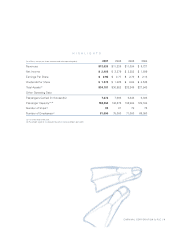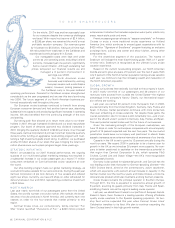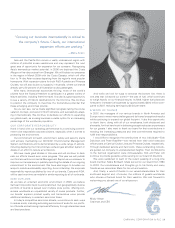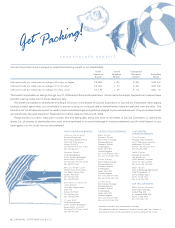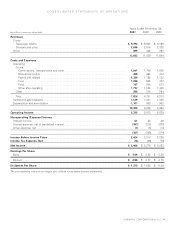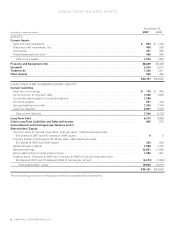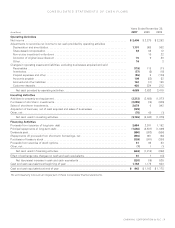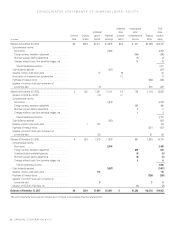Carnival Cruises 2007 Annual Report Download - page 14
Download and view the complete annual report
Please find page 14 of the 2007 Carnival Cruises annual report below. You can navigate through the pages in the report by either clicking on the pages listed below, or by using the keyword search tool below to find specific information within the annual report.CARNIVAL CORPORATION & PLC | 11
Trademarks
The costs of developing and maintaining our trademarks
are expensed as incurred. For certain of our acquisitions we
have allocated a portion of the purchase prices to the acquiree’s
identified trademarks. Trademarks are estimated to have an
indefinite useful life and, therefore, are not amortizable, but
are reviewed for impairment annually, or, when events or
circumstances dictate, more frequently. Our trademarks would
be considered impaired if their carrying value exceeds their
estimated fair value.
Derivative Instruments and Hedging Activities
We utilize derivative and nonderivative financial instruments,
such as foreign currency swaps, foreign currency debt obliga-
tions and foreign currency cash balances, to limit our exposure
to fluctuations in foreign currency exchange rates, and interest
rate swaps to manage our interest rate exposure and to
achieve a desired proportion of variable and fixed rate debt
(see Notes 5 and 10).
All derivatives are recorded at fair value, and the changes
in fair value are immediately included in earnings if the deriva-
tives do not qualify as being effective hedges. If a derivative
is a fair value hedge, then changes in the fair value of the
derivative are offset against the changes in the fair value of the
underlying hedged item. If a derivative is a cash flow hedge,
then changes in the fair value of the derivative are recognized
as a component of accumulated other comprehensive income
(“AOCI”) until the underlying hedged item is recognized in
earnings. If a derivative or a nonderivative financial instrument
is designated as a hedge of our net investment in a foreign
subsidiary, then changes in the fair value of the financial
instrument are recognized as a component of AOCI to offset
a portion of the change in the translated value of the net
investment being hedged, until the investment is liquidated.
We formally document all hedging relationships for all deri-
vative and nonderivative hedges and the underlying hedged
items, as well as our risk management objectives and strate-
gies for undertaking the hedge transactions.
We classify the fair value of our derivative contracts and
the fair value of our offsetting hedged firm commitments as
either current or long-term, which are included in prepaid
expenses and other assets and accrued and other liabilities,
depending on whether the maturity date of the derivative
contract is within or beyond one year from our balance sheet
dates. The cash flows from derivatives treated as hedges are
classified in our Consolidated Statements of Cash Flows in
the same category as the item being hedged.
During fiscal 2007, 2006 and 2005, all net changes in the
fair value of both our fair value hedges and the offsetting
hedged firm commitments and our cash flow hedges were
immaterial, as were any ineffective portions of these hedges.
No fair value hedges or cash flow hedges were derecognized
or discontinued in fiscal 2007, 2006 or 2005. In addition, the
amount of realized net losses or gains from cash flow hedges
that were reclassified into earnings during fiscal 2007, 2006
and 2005 were not significant. The amount of estimated cash
flow hedges unrealized net losses which are expected to be
reclassified to earnings in the next twelve months is also
not significant.
If any shipyard with which we have contracts to build our
ships is unable to perform, we would be required to perform
under our foreign currency swaps related to these shipbuilding
contracts. Accordingly, based upon the circumstances, we
may have to discontinue the accounting for those currency
swaps as hedges, if the shipyard cannot perform. However,
we believe that the risk of shipyard nonperformance is remote.
Revenue and Expense Recognition
Guest cruise deposits represent unearned revenues and are
initially recorded as customer deposit liabilities when received.
Customer deposits are subsequently recognized as cruise
revenues, together with revenues from onboard and other
activities, which include transportation and shore excursion
revenues and all associated direct costs of a voyage, upon
completion of voyages with durations of ten nights or less and
on a pro rata basis for voyages in excess of ten nights. Future
travel discount vouchers issued to guests are typically recorded
as a reduction of revenues when such vouchers are utilized.
Cancellation fees are recognized in revenues at the time of
the cancellation. Revenues and expenses from our tour and
travel services are recognized at the time the services are
performed or expenses are incurred. Port and other taxes
assessed on a per guest basis by a government or quasi-
governmental entity are excluded from expenses as they are
presented on a net basis against the corresponding amounts
collected from our guests, which are excluded from revenues.
Our sale to guests of air and other transportation to and
from our ships and the related cost of purchasing this service
is recorded as cruise passenger ticket revenues and cruise
transportation costs, respectively. The proceeds that we collect
from the sale of third party shore excursions and on behalf
of onboard concessionaires, net of the amounts remitted to
them, are recorded as concession revenues, on a net basis,
in onboard and other cruise revenues.


